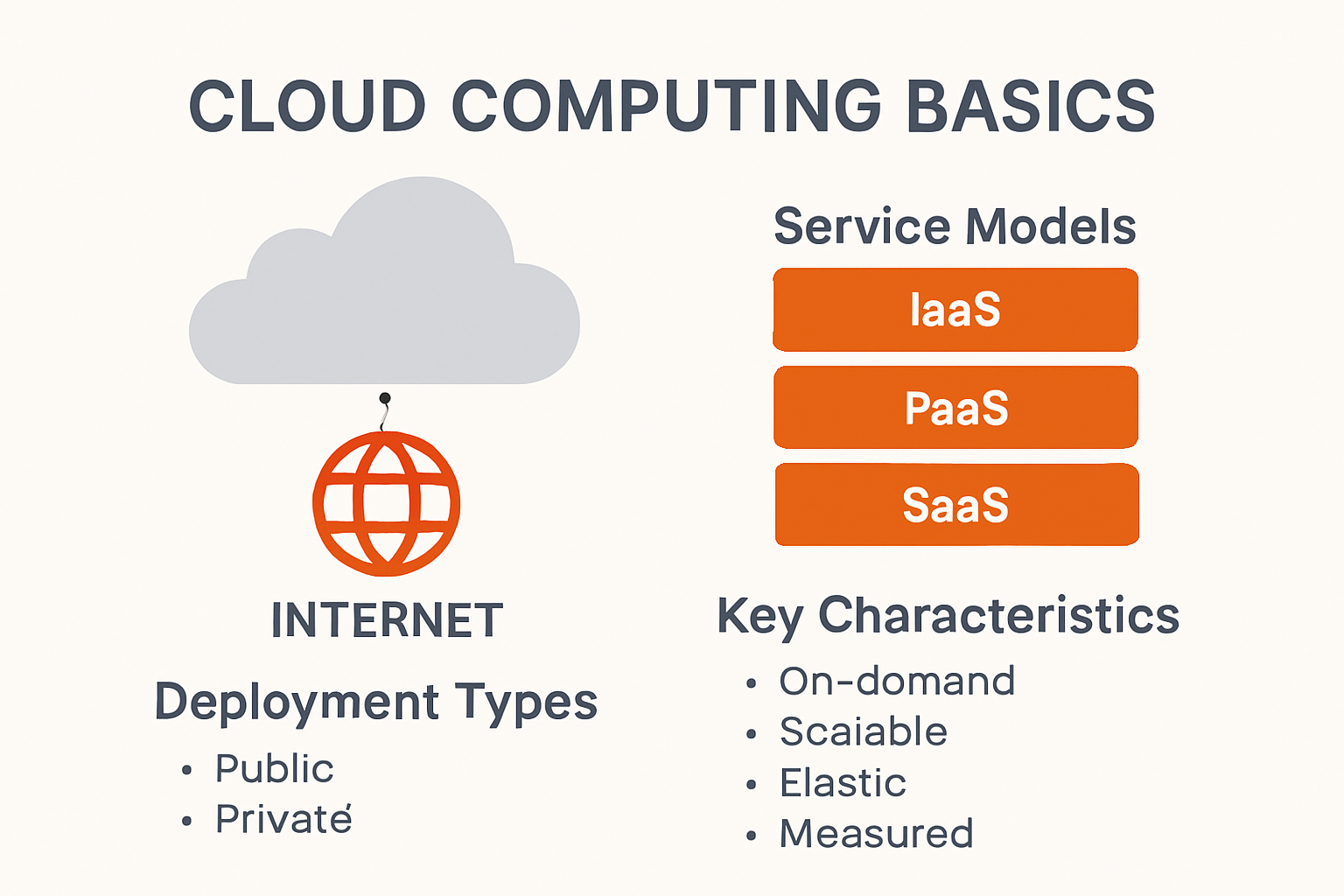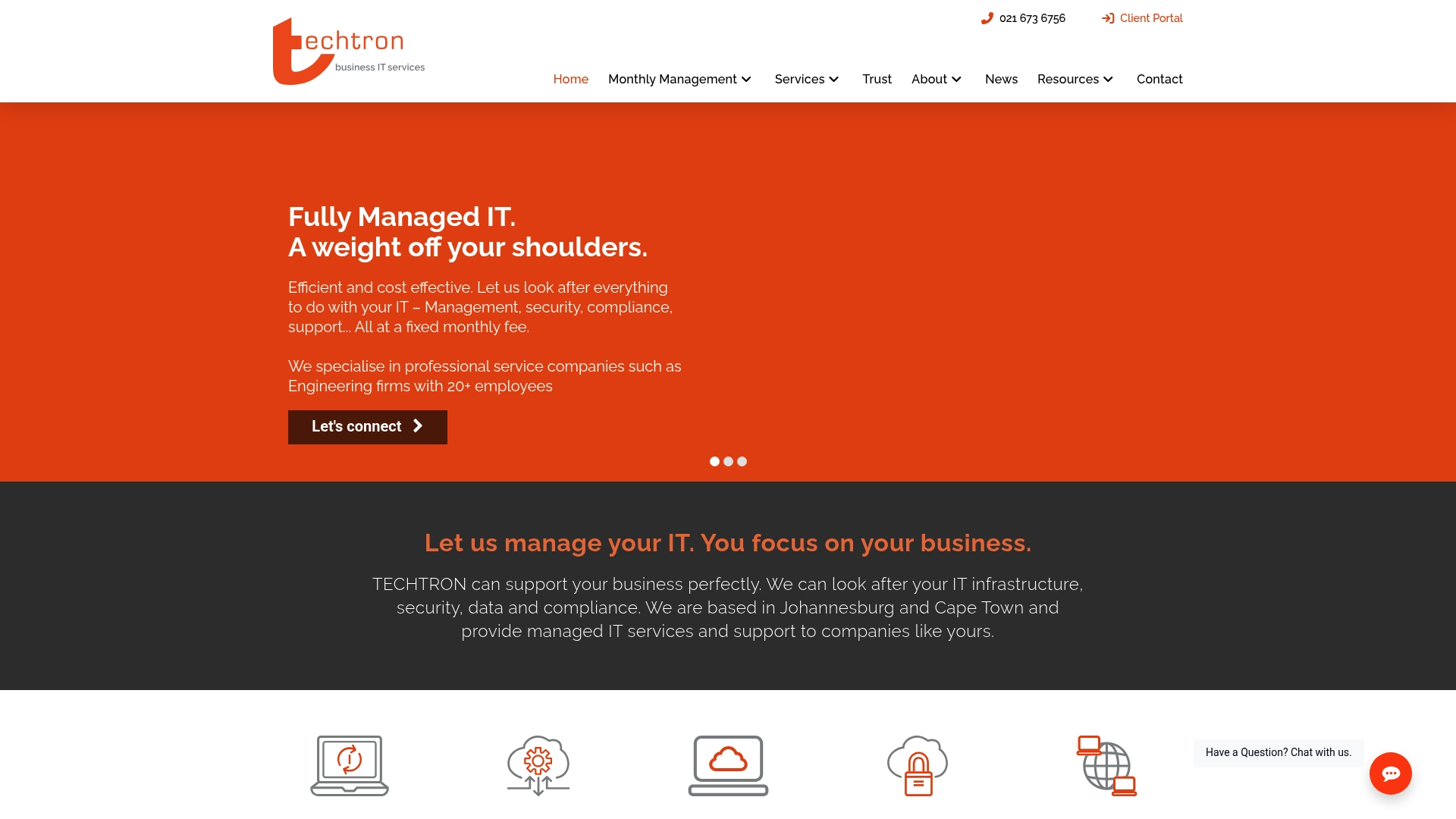Cloud Computing Basics for Mid-Sized Companies in 2025

Cloud computing is shaking up the way mid-sized businesses work. Companies are finding that by 2025, over 70 percent of professional service firms have cut IT costs by moving to the cloud. Sounds expensive to switch over, right? Turns out most are saving more than ever before and getting better security and flexibility on top of it.
Table of Contents
- What Is Cloud Computing And How It Works
- Key Benefits For Professional Service Companies
- Cloud Security And Data Protection Best Practices
- Choosing The Right Cloud Model For Your Business
Quick Summary
| Takeaway | Explanation |
|---|---|
| Cost-Effective Technology Infrastructure | Cloud computing transforms capital expenditure into predictable operational costs, allowing professional service companies to allocate resources efficiently towards core business activities rather than IT infrastructure maintenance. |
| Enhanced Security and Business Continuity | Leveraging advanced security protocols and automatic data backups, cloud technologies provide professional service companies with enhanced protection against cyber threats and reliable business continuity during disruptions. |
| Scalability and Collaborative Potential | Cloud computing enables businesses to dynamically adjust resources according to project demands, facilitating growth and seamless collaboration across geographical locations, which is vital for modern operations. |
| Choosing the Right Cloud Model | It’s crucial for professional service companies to assess their specific needs against various cloud deployment models, such as public, private, and hybrid, to find the optimal balance between cost, security, and operational flexibility. |
| Implementing Best Practices for Cloud Security | Adopting a comprehensive risk management strategy, maintaining advanced technical safeguards, and recognizing shared security responsibility are essential actions for protecting sensitive information in the cloud. |
What Is Cloud Computing and How It Works
Cloud computing represents a revolutionary approach to managing and delivering computing resources that transforms how businesses handle their technological infrastructure. At its core, cloud computing enables organisations to access and utilize computing power, storage, and services over the internet, eliminating the need for extensive on-site hardware and complex infrastructure management.

Core Components of Cloud Computing
Cloud computing is built on a sophisticated framework of interconnected technologies and services. According to the General Services Administration, cloud computing encompasses five essential characteristics that define its functionality and flexibility:
- On-Demand Self-Service: Businesses can provision computing resources automatically without requiring direct interaction with service providers.
- Broad Network Access: Cloud services are accessible through standard network mechanisms and multiple client platforms.
- Resource Pooling: Computing resources are dynamically allocated and reallocated based on organisational needs.
- Rapid Elasticity: Services can be quickly scaled up or down to match fluctuating business requirements.
- Measured Service: Cloud systems automatically monitor and optimize resource utilization.
Here’s a summary table highlighting the five essential characteristics of cloud computing and what they enable for businesses:
| Characteristic | What it Enables for Businesses |
|---|---|
| On-Demand Self-Service | Provision resources automatically, reducing wait times for IT services |
| Broad Network Access | Access cloud services from anywhere via various devices |
| Resource Pooling | Share and dynamically allocate resources based on need, improving efficiency |
| Rapid Elasticity | Scale services up or down quickly to meet business demand |
| Measured Service | Monitor and optimize usage for cost-control and resource planning |
Cloud Service and Deployment Models
Research from the University of Washington’s Information Technology department highlights three primary service models that businesses can leverage:
-
Infrastructure as a Service (IaaS): Provides virtualized computing resources over the internet, allowing businesses to rent virtual machines, storage, and networking capabilities.
-
Platform as a Service (PaaS): Offers a comprehensive development and deployment environment, enabling companies to build, test, and deploy applications without managing underlying infrastructure.
-
Software as a Service (SaaS): Delivers fully functional software applications via the internet, eliminating the need for local installation and maintenance.
Deployment models further diversify cloud computing options. These include public clouds (shared resources accessible to everyone), private clouds (dedicated infrastructure for a single organization), community clouds (shared by multiple organizations with common interests), and hybrid clouds (combining multiple deployment models).
For mid-sized companies, cloud computing offers substantial advantages. It provides scalable, cost-effective solutions that adapt to changing business needs while reducing capital expenditure on physical IT infrastructure. By leveraging cloud technologies, organizations can focus more on core business objectives and less on complex technological management.
Understanding cloud computing requires recognizing its fundamental promise: delivering powerful, flexible, and accessible technological resources that empower businesses to innovate, grow, and compete more effectively in an increasingly digital world.
Key Benefits for Professional Service Companies
Professional service companies operate in an increasingly complex technological environment where efficiency, security, and adaptability are paramount. Cloud computing emerges as a transformative solution that addresses these critical business needs, offering strategic advantages that extend far beyond traditional IT infrastructure.
Cost-Effective Technology Infrastructure
According to the U.S. Government Accountability Office, cloud computing provides substantial financial benefits for private sector companies. Professional service firms can significantly reduce capital expenditure by eliminating substantial upfront investments in physical hardware and maintaining expensive on-site data centers. Instead, businesses can leverage pay-as-you-go cloud services, converting large capital expenses into predictable operational costs.
The financial flexibility allows professional service companies to allocate resources more strategically. Rather than dedicating substantial budgets to IT infrastructure maintenance, organizations can invest in core business development, talent acquisition, and innovative service offerings. Research from ResearchGate confirms that cloud computing enables small and medium-sized enterprises to achieve remarkable cost reductions while maintaining technological competitiveness.

Enhanced Security and Business Continuity
Cloud computing introduces robust security frameworks that are often more sophisticated than traditional in-house IT systems. Professional service companies handling sensitive client data can benefit from advanced security protocols, including encryption, multi-factor authentication, and continuous monitoring. These features provide comprehensive protection against potential cybersecurity threats.
Business continuity becomes significantly more reliable with cloud technologies. Automatic data backups, distributed storage, and rapid disaster recovery mechanisms ensure that critical business information remains safe and accessible, even during unexpected disruptions. The National Association of Software and Service Companies emphasizes that cloud computing offers automatic updates and comprehensive disaster recovery solutions, which are crucial for maintaining uninterrupted service delivery.
Scalability and Collaborative Potential
Cloud computing empowers professional service companies with unprecedented scalability. Businesses can dynamically adjust their computational resources based on current project demands, ensuring optimal performance without overprovisioning. This elasticity allows companies to respond quickly to market changes, scale operations during peak periods, and maintain lean, efficient technological infrastructures.
Collaboration represents another significant advantage. Cloud platforms enable seamless communication and file sharing across geographic boundaries, facilitating remote work and global team integration. Professionals can access shared documents, collaborate in real-time, and maintain synchronized workflows, regardless of physical location.
While cloud computing offers remarkable benefits, professional service companies should explore comprehensive service agreements to ensure optimal implementation and ongoing support. Understanding the nuanced approach to cloud technology adoption can transform technological challenges into strategic opportunities for growth and innovation.
Cloud Security and Data Protection Best Practices
Cloud security represents a critical cornerstone for professional service companies navigating the complex digital ecosystem. As organizations increasingly rely on cloud technologies, implementing robust data protection strategies becomes paramount to safeguarding sensitive information and maintaining client trust.
Comprehensive Risk Management Approach
According to the Federal Trade Commission, organizations must adopt a proactive approach to cloud security. This involves conducting thorough data inventories, minimizing unnecessary data storage, and understanding that security remains fundamentally the organization’s responsibility.
Key risk management strategies include:
- Vendor Assessment: Rigorously evaluate potential cloud service providers
- Security Alignment: Ensure cloud strategies directly support business objectives
- Continuous Monitoring: Implement ongoing risk assessment protocols
Research from the U.S. Government Accountability Office highlights that leading private sector companies employ clear acquisition terms and robust cybersecurity measures as fundamental components of their cloud security frameworks.
Advanced Technical Safeguards
Technical security measures form the backbone of effective cloud protection. Professional service companies must deploy sophisticated tools and protocols to ensure comprehensive data defense. ISACA recommends several critical technical safeguards, including:
- Encryption Management: Securely managing encryption keys across all data transmission and storage stages
- Cloud Access Security Brokers (CASBs): Implementing intermediary services that provide visibility and control over cloud application usage
- Redundancy Protocols: Ensuring data availability through multiple backup and recovery mechanisms
These technical interventions help create multi-layered defense strategies that protect against potential cyber threats and unauthorized access attempts.
Below is a table categorising technical cloud security measures and their primary purposes for professional service companies:
| Security Measure | Main Purpose |
|---|---|
| Encryption Management | Protects data confidentiality in transit & at rest |
| Cloud Access Security Broker | Monitors and controls usage of cloud applications |
| Redundancy Protocols | Ensures data availability via backup & recovery |
Shared Security Responsibility
Cloud security is not solely the responsibility of service providers. Professional service companies must actively participate in maintaining robust security frameworks. This shared responsibility model requires organizations to:
- Understand specific security responsibilities within cloud service agreements
- Implement additional security layers beyond provider-standard protections
- Train workforce on cloud security best practices
- Regularly update and patch systems
- Conduct periodic security audits and penetration testing
By adopting a holistic approach to cloud security, professional service companies can transform potential vulnerabilities into strategic advantages. Learn more about our comprehensive service agreements that provide robust security and support for your cloud infrastructure.
Ultimately, cloud security is not about eliminating all risks but about managing them intelligently, maintaining operational resilience, and protecting the valuable digital assets that drive business success.
Choosing the Right Cloud Model for Your Business
Selecting the appropriate cloud computing model is a critical strategic decision that can significantly impact a professional service company’s technological efficiency, cost management, and operational flexibility. Understanding the nuanced characteristics of different cloud deployment models enables businesses to make informed choices that align with their specific operational requirements and growth objectives.
Cloud Deployment Model Landscape
According to the U.S. Congressional Research Service, four primary cloud deployment models exist: public, private, community, and hybrid clouds. Each model offers distinct advantages and challenges that professional service companies must carefully evaluate.
Public Cloud
- Shared infrastructure managed by third-party providers
- Lower initial investment
- Highly scalable resources
- Reduced maintenance responsibilities
Private Cloud
- Dedicated infrastructure for a single organization
- Enhanced security and compliance controls
- Greater customization potential
- Higher initial implementation costs
Hybrid Cloud
- Combination of public and private cloud environments
- Flexible workload distribution
- Balanced approach to security and cost-efficiency
- Complex integration requirements
The following table compares key features of the main cloud deployment models available to professional service companies:
| Model | Infrastructure | Scalability | Security/Compliance | Cost | Example Use Case |
|---|---|---|---|---|---|
| Public Cloud | Shared (third-party) | High | Standard | Low initial | Scalable web apps, variable workloads |
| Private Cloud | Dedicated | Moderate to High | Enhanced | Higher initial | Sensitive data, strict compliance needs |
| Hybrid Cloud | Mixed (Public/Priv) | Flexible | Balanced | Moderate | Bursty workloads, phased migrations |
Strategic Considerations for Model Selection
IBM highlights that small and mid-sized businesses must consider multiple factors when selecting a cloud model. Key strategic considerations include:
- Compliance Requirements: Regulated industries like financial services may require stringent data protection measures
- Budget Constraints: Balancing initial investment with long-term operational expenses
- Performance Needs: Assessing computational and storage requirements
- Security Expectations: Evaluating data sensitivity and protection mechanisms
Hybrid Cloud: A Balanced Approach
Computerworld research suggests that hybrid cloud models offer the most flexible solution for professional service companies. This approach allows businesses to:
- Maintain sensitive data on private infrastructure
- Leverage public cloud scalability for variable workloads
- Optimize cost-efficiency
- Implement phased migration strategies
- Retain greater control over critical business applications
Professional service companies must conduct comprehensive assessments of their technological ecosystem, future growth projections, and specific operational requirements. Explore our comprehensive service agreements to understand how tailored cloud solutions can transform your business infrastructure.
Ultimately, the right cloud model is not a one-size-fits-all solution but a strategic alignment between technological capabilities, business objectives, and organizational culture. Careful evaluation, ongoing assessment, and adaptable implementation are key to successful cloud integration.
Frequently Asked Questions
What is cloud computing?
Cloud computing refers to the delivery of computing services, such as storage and processing power, over the internet. It allows businesses to access resources without relying on extensive on-site infrastructure.
What are the key benefits of cloud computing for mid-sized companies?
Mid-sized companies can benefit from cloud computing through cost savings, improved security, scalability, and enhanced collaboration. By reducing IT expenses, companies can focus on core business activities while maintaining flexibility in resource management.
How do I choose the right cloud model for my business?
Selecting the right cloud model involves assessing your specific needs, compliance requirements, budget constraints, and performance needs. Common models include public, private, and hybrid clouds, each offering different advantages.
What best practices should I follow for cloud security?
To ensure cloud security, adopt a comprehensive risk management approach, implement advanced technical safeguards, and understand the shared security responsibility between your organisation and the cloud provider. Regular audits and staff training are also crucial.
Bridge the Gap From Cloud Uncertainty to Business Clarity
If you are still wondering how to choose the right cloud solution or manage the risks of moving your IT off-site, you are not alone. Many mid-sized companies face these same challenges. The reality is that insecure cloud planning and unmanaged infrastructure can stall growth, disrupt teams, and leave your client data exposed. You deserve a specialist partner who understands the pressure of compliance, uptime, and the need for seamless collaboration that the article covered in depth.

Stop letting uncertainty with cloud migration or security hold your business back. With Techtron’s expert managed IT services, you get a team dedicated to turning cloud complexity into simple, secure, scalable solutions. We tailor each strategy for professional firms like yours and offer ongoing support you can trust. Discover how partnering with us delivers security, reliability and the peace of mind you need to focus on your core work.
Visit our home page today and reach out for a confidential assessment. Make your next step toward a smarter, future-ready cloud journey now.
Recommended
- Reasons to migrate to Windows Server 2019 | TECHTRON
- Choosing Service Agreements vs. Ad-Hoc IT Support | TECHTRON
- What to choose – service agreements or ad hoc | TECHTRON
- The many benefits of cloud computing | TECHTRON
- 7 Cloud Accounting Benefits for Small Business Growth – Ready Accounting
- Production Test Explained: Best Practices and Tools for 2025